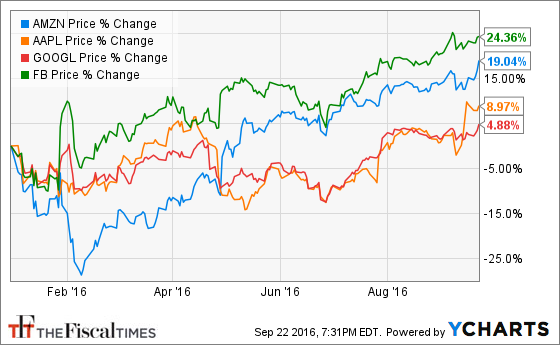It's feeling like 1999 again. The Clintons are in the headlines. Everyone is enamored with new technologies (VR, autonomous vehicles, robotics). And the sluggish pace of rate hikes from the Federal Reserve is growing a nice bubble in financial markets. Investors don’t see any more attractive options for their money, so stocks keep chugging ahead.
Never mind a corporate earnings recession now in its sixth quarter. Never mind the outright contraction in manufacturing activity. Never mind disappointing GDP growth. Or the recent slowdown in job gains.
After the Fed delivered its "no hike" policy decision on Wednesday just as Wall Street wanted, we're back to the races. The tech-heavy Nasdaq Composite has surged to new highs for two straight days. At the same time, investors are shunning boring areas of the market like consumer staples. That could be a problem, as I'll explain.
Related: Will Our Rotten Politicians Kill This Bull Market?
First, let's revel in the areas moving higher. The Nasdaq gapped over the 5,300 level on Thursday, breaking out of a three-month sideways channel that's capped a two-year flirtation with resistance near the 5,200 level. The index is in clear air now and well above the dotcom bubble high of 5,132.
The stocks driving the move are the who's who of big-tech investing. Facebook (FB) looks ready to jump above $132 a share to a record, up more than 650 percent from its post-IPO low of $17.55 set in 2012. Amazon (AMZN) shares appear to be riding one of its newfangled delivery drones higher and higher, soaring above the $800 level for the first time. Alphabet (GOOGL) is making a run at $820. Even Apple (AAPL) is on the mend, as interest in the iPhone 7 has transcended the underwhelming initial reaction to its unveiling. Shares are up about 25 percent from their May low.
Old guard tech stocks are playing along too. Microsoft (MSFT) is closing in on its record high set in August thanks to the announcement of a bigger dividend and a new share buyback program. Chipmaker Intel (INTC) has returned to levels not seen since 2000, up 20 percent since May, thanks to reports of rebounding PC demand and inventory restocking. Even tech turnaround plays like Yahoo! (YHOO) and HP (HPQ) have been climbing higher.
Related: Theft of 500 Million Yahoo Accounts Is the Biggest Single Hack Ever
Yet other areas of the market are being left in the dust. Cyclical sectors like financials, materials and energy are being ignored. Retail is in the tank. And defensive areas like consumer staples are underperforming.
No wonder then that, while the superstars in the Nasdaq are riding high, broader measures of the stock market such as the NYSE Composite Index are well below record levels. The index is down about 4 percent from highs seen in May 2015 and is trading at levels first reached in the summer of 2014.
The result is a dangerous narrowing of market breadth that's creating a sense the move in big-tech is all about momentum and chasing returns, not about reasoned investments in future earnings growth — classic, late-stage bull market behavior, but the sort that is very risky for those that don't realize the broader context of these moves.
If you want to chase the rise in tech, be aware these are trades; this environment isn't conducive to buy-and-hold thinking. At least, not unless buyers quickly broaden their interest to stocks outside the tech sector.
Related: Record Number of Americans Have $5 Million to Invest
Jason Goepfert at SentimenTrader notes that the Nasdaq was alone in setting a new high on Wednesday, with the other major averages all closing more than 1 percent below their own highs — the first time this has happened to such a degree since 1999. Going back 40 years, the historic result has typically been some near-term weakness (the S&P 500 managed to rise in only two of six occurrences two weeks later) before the enthusiasm spread to other areas and the market gains become more broad-based.
Turning back to consumer staples stocks, Goepfert finds that less than 20 percent of shares in that area have been trading above their 50-day moving averages, a sign of just how forlorn these names are. Since the bull market began, such a thing has only happened two times before: in June 2010 and in August 2011. The good news is that both times marked a low for staples stocks.
The moral of the story: Unless stocks like Coca-Cola (KO) and Wal-Mart (WMT) perk up soon and follow the lead of tech favorites like Amazon, it could be a sign that the Fed's latest stock market bubble has entered its terminal, and most dangerous, stage.







